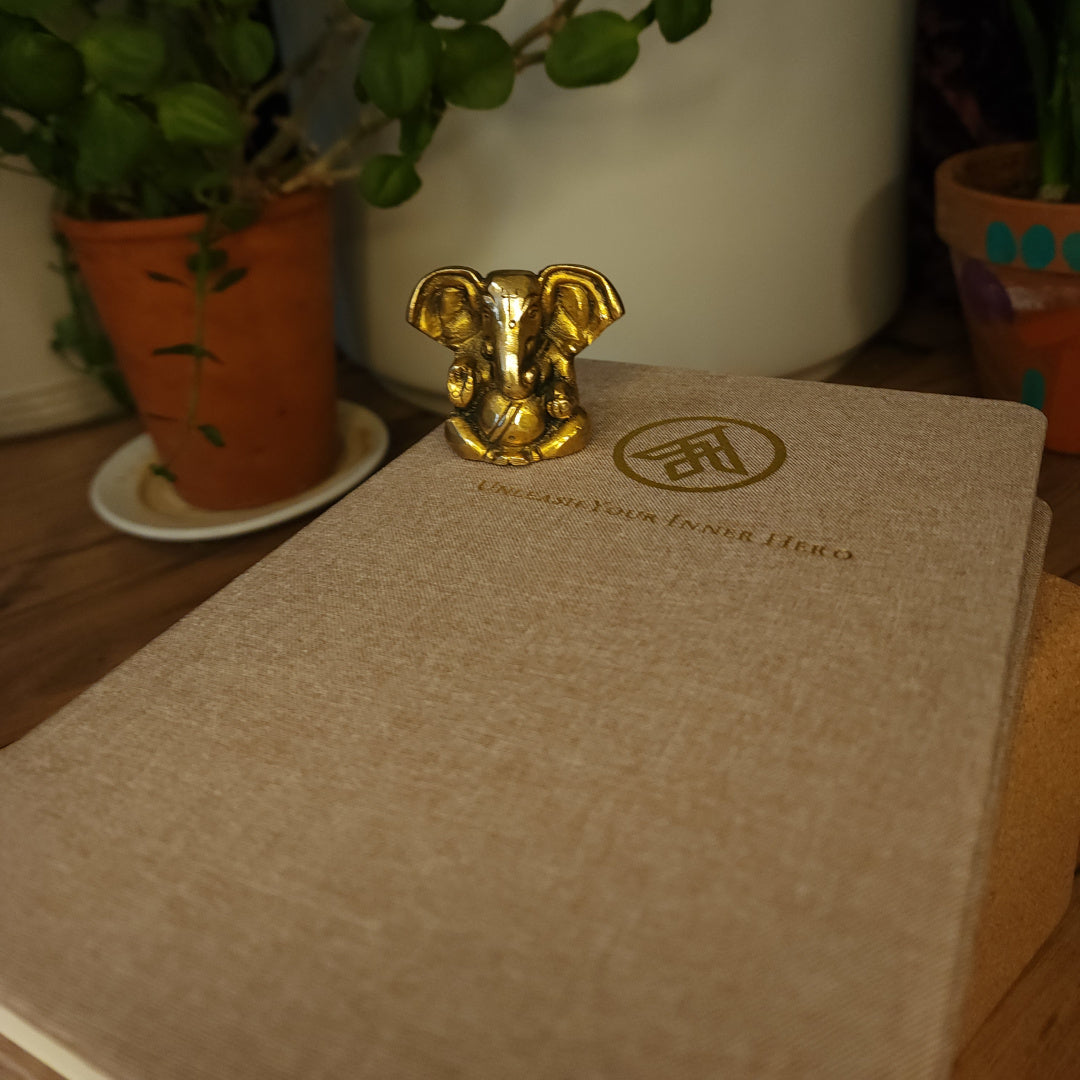
Antahkarana: Understanding the Mind for American Yogis
Jack UtermoehlShare
From Mental Turbulence to Peace of Mind
Have you ever felt your mind spinning out of control—caught in a relentless cycle of stress, confusion, and emotional reactions? Maybe you've experienced days when even minor decisions seem overwhelming, leaving you frustrated, exhausted, or stuck. We all face these moments when our thoughts race, emotions flare, and clarity feels impossible.
Many turn to yoga for relief, yet often associate it solely with physical poses and flexibility. But yoga offers much more. Beyond the physical postures (asanas) lies a powerful system designed specifically to understand, refine, and master the mind.
At the heart of this system is the concept of Antahkarana, the yogic framework for comprehending how we think, feel, and act.
Antahkarana, meaning "inner instrument" in Sanskrit, provides a clear, structured map of the mind, revealing why we react the way we do—and more importantly, how we can shift from emotional turbulence to inner peace, from indecision to wisdom.
By grasping this yogic understanding, we begin a journey not just toward mental clarity, but toward genuine self-awareness and inner peace.

What is Antahkarana? Understanding the Inner Instrument
Antahkarana (Sanskrit: अन्तःकरण) translates literally as “inner instrument” or “inner faculty.”
In yogic philosophy, this term refers to the internal system that shapes your thoughts, emotions, decisions, and overall awareness.
Think of Antahkarana as the mind’s inner machinery—the behind-the-scenes framework that processes every experience, filters perception, and ultimately influences how you react to life’s events. It’s not a singular entity, but rather a dynamic interplay of mental functions working together to create your subjective reality.
Specifically, yogic tradition breaks down Antahkarana into four interconnected components:
- Manas (sensory mind)
- Buddhi (intellect)
- Ahamkara (ego or identity)
- Citta (memory or consciousness)
When you clearly understand how these faculties operate within you, you gain insight into your mental patterns and emotional reactions. Instead of being swept up by automatic responses, you can begin to guide your mind consciously and purposefully—transforming inner confusion into clarity and reactivity into wisdom.

Why Modern Yogis Should Care
In today’s fast-paced world, mental overwhelm is common:
- Stress feels constant
- Anxiety is a familiar companion
- Mental fog clouds clear thinking
- Emotional instability disrupts your peace
Yet most suffering (dukha) arises from misunderstanding your own mind.
Without knowing how your internal faculties function, you're left reacting rather than choosing. Ignorance makes the mind feel unpredictable, out of control, chaotic.
Yoga calls this ignorance avidya (the root of suffering).
But there's a path out:
- Know your inner instrument (Antahkarana).
- See clearly how thought, emotion, and identity operate.
- Transform unconscious reactions into conscious actions.
Awareness naturally leads to clarity, and clarity, in turn, fosters inner peace. Once inner peace is established within, wisdom becomes accessible, guiding you through life's challenges with greater ease and intention.
Antahkarana offers you a practical blueprint for this journey—from confusion toward clarity, anxiety toward emotional stability, and impulsive reactions toward conscious, empowered choices.
This deeper understanding of your mind is yoga’s profound gift, enabling you to release unnecessary suffering and experience genuine peace.

The Four Components of Antahkarana
Understanding your inner instrument requires looking closely at its four interconnected parts. Each plays a distinct yet collaborative role in how you perceive reality, process experiences, and react to the world around you.
Manas (Sensory Mind)
Manas acts as your mind’s primary gatekeeper.
Function: Processes sensory input, generates immediate reactions and emotions.
Nature: Reactive, moment-to-moment, easily swayed.
Example: Feeling instant excitement or fear when something surprising happens.
Every sound, touch, image, scent, and taste first passes through this sensory processing center. It swiftly translates these impressions into initial reactions—like excitement from a compliment or anxiety triggered by an unexpected noise.
Because of its responsive nature, Manas easily becomes scattered or overwhelmed by excessive stimulation, leaving you restless, indecisive, or emotionally volatile.
Yet, Manas isn't equipped to discern deeply or choose wisely. Its role is simply to collect and respond instantly, not judge or reflect.
This makes it vulnerable to habitual reactivity—trapping you in patterns of emotional upheaval unless consciously managed through mindful awareness, breathwork (pranayama), or sensory withdrawal (pratyahara).
Citta (Memory/Consciousness)
Citta is the repository of all past experiences, impressions, and subconscious patterns.
Function: Stores memories, habits, and deep mental impressions (samskaras).
Nature: Subtle, influential, rooted in past experiences.
Example: Overreacting to a neutral situation due to hidden emotional wounds or unresolved memories.
Each event in your life leaves behind subtle imprints—known in yoga as samskaras—that quietly influence your future perceptions and behaviors. Often, without realizing it, your current reactions reflect past conditioning rather than objective reality.
For instance, a minor disagreement may trigger intense emotions due to unhealed past experiences or unconscious fears stored deep within Citta.
Because it holds the roots of your emotional habits and tendencies, purifying Citta is a key step toward emotional clarity. Practices like meditation, mindfulness, journaling, or intentional reflection help illuminate these subconscious patterns, enabling you to consciously reshape them and free yourself from automatic, conditioned responses.
Ahamkara (Ego/Identity)
Ahamkara is the faculty responsible for building and maintaining your personal identity.
Function: Forms and maintains personal identity—your "I" sense.
Nature: Protective, possessive, defensive; creates separateness.
Example: Becoming defensive when criticized or overly proud when praised.
It's the inner voice declaring, "I am successful," or "I am inadequate," or "this is mine." This ego-driven identity separates you from others, creates a boundary around your sense of self, and often tries to protect or defend your image.
While a certain degree of identity is necessary for functioning in the world, attachment to this identity can lead to pain, defensiveness, or pride.
When overly identified with ego, you become reactive—defensive when challenged or excessively attached to your successes and failures.
Yoga teaches you not to destroy your identity, but to see clearly that your true Self (Atman) lies beyond these temporary definitions. Practices like humility, gratitude, and selfless service (seva) gently soften the grip of Ahamkara, creating space for a deeper, more expansive awareness.
Buddhi (Intellect/Discernment)
Buddhi is the wise voice within you—quiet, clear, and discerning.
Function: Discerns clearly, makes wise decisions, sees beyond impulse.
Nature: Calm, clear, insightful, reflective.
Example: Choosing long-term health over instant gratification, even when tempted otherwise.
Unlike the reactive Manas or the ego-driven Ahamkara, Buddhi evaluates, reflects, and makes decisions aligned with your deeper values and truths. It’s your inner compass, guiding you away from impulse and toward thoughtful, intentional action.
When Buddhi is strong and clear, you can pause before reacting emotionally, recognize what’s beneficial over the long-term, and make wise, grounded choices.
Cultivating Buddhi involves nurturing space for clarity—whether through meditation, contemplation, study of spiritual texts, or reflective journaling. The more you strengthen this discerning faculty, the less you’ll be swayed by momentary desires or impulses.
Buddhi guides you toward a life of intentionality, authenticity, and deeper spiritual fulfillment.

Practical Examples of Everyday Antahkarana Use
Imagine a scenario:
It's Monday morning, and you're running late for work. As you rush through the kitchen, your elbow accidentally knocks your favorite coffee mug off the counter, sending it crashing to the floor.
Immediately, Manas leaps into action—triggering instant feelings of frustration, stress, and irritation. You feel a spike of annoyance surge through you, an emotional reaction to the sound and your attachment to the cup surfaces at the sight of the shattered mug.
As you stare at the broken pieces scattered across the tile, Citta, your memory bank, quietly awakens beneath the surface.
You suddenly recall similar rushed mornings, past episodes of feeling overwhelmed, or perhaps even memories of childhood when mistakes led to scolding or shame. Without even realizing it, your emotional intensity escalates, fueled by these subconscious impressions—turning a small mishap into a significant emotional event.
Then, almost immediately, Ahamkara steps forward—the voice of your ego reinforcing identity-driven narratives.
You start telling yourself, "Why am I always so careless?" or "This always happens to me!" A sense of defensiveness, inadequacy, or victimhood starts to build. Your self-image feels threatened by a simple accident, intensifying stress and frustration further.
But just as emotions threaten to spiral out of control, Buddhi, your inner wisdom, gently steps into the picture.
In the brief pause you allow yourself, you recognize what's happening inside: You're reacting strongly not because of the broken mug, but because of deeper patterns and self-critical thoughts triggered unconsciously. Your intellect quietly suggests taking a breath, stepping back, and seeing the situation for what it is—a minor inconvenience, not a personal failing or catastrophe.
As you pause, breathing intentionally, Buddhi’s clarity deepens. You realize you have a choice: you can let frustration and negative self-talk dominate your morning—or consciously let go of your attachment to perfection and identity-driven stories. You calmly clean up the broken mug, noticing the emotional reaction fade as awareness takes hold.
In this simple moment, you've witnessed all four aspects of Antahkarana interacting:
- Manas initially reacting emotionally and impulsively.
- Citta bringing past impressions to amplify the present.
- Ahamkara intensifying the situation through self-focused narratives.
- Buddhi stepping in to clarify, calm, and redirect your reaction toward wisdom and equanimity.
Through awareness and intentional action, the yogic framework of Antahkarana transforms everyday struggles into opportunities for profound personal growth and self-understanding.

Benefits of Understanding the Inner Mind
When you understand how your inner instrument (Antahkarana) works, every aspect of your life improves—mentally, emotionally, and spiritually. Here’s what happens when you master this subtle yogic framework:
1. Emotional Balance and Stability
- You become less reactive and more emotionally grounded.
- Stressful situations no longer hijack your inner peace.
- You recover quickly from emotional disturbances, increasing resilience.
2. Clearer, Wiser Decision-Making
- Buddhi (intellect) sharpens, helping you discern clearly and wisely.
- Choices become intentional, aligned with deeper values.
- Intuition strengthens, providing reliable inner guidance.
3. Greater Self-Awareness and Mindfulness
- Increased insight into your reactions and behaviors.
- Enhanced ability to pause, reflect, and respond consciously.
- Improved empathy and connection in relationships.
4. Improved Mental Clarity and Focus
- Reduced mental fog, confusion, and scattered thinking.
- Increased concentration and efficiency in tasks.
- Enhanced ability to prioritize and stay aligned with your goals.
5. Reduced Anxiety and Stress
- Understanding the mind reduces unnecessary mental turbulence.
- Greater mental clarity brings relief from worry and anxiety.
- You naturally cultivate a calmer, more grounded presence.
6. Healthier Relationships and Communication
- Recognizing ego patterns (Ahamkara) reduces defensiveness.
- Improved emotional awareness supports more authentic connections.
- You communicate more clearly, openly, and compassionately.
7. Increased Emotional Intelligence (EQ)
- Ability to accurately identify, understand, and manage emotions.
- Improved empathy toward self and others.
- Greater emotional maturity in personal and professional interactions.
8. Enhanced Creativity and Problem-Solving
- Inner stillness opens space for creative insights.
Improved discernment helps identify innovative solutions.
Clear mind supports effortless creative flow.
9. Greater Spiritual Connection and Depth in Yoga Practice
- Mindfulness deepens your meditation and asana practice.
- You experience yoga as a meaningful journey beyond physical poses.
- Awareness of Antahkarana brings profound spiritual insights and growth.
10. Authentic Living and Alignment with Purpose
- You live more aligned with your core values and true nature.
- Reduced attachment to ego-driven narratives frees you to live authentically.
- Clarity about who you are guides purposeful action and fulfillment.
When you master the inner instrument of your mind, life becomes less about coping and more about consciously thriving—emotionally, mentally, and spiritually.

Practical Steps to Strengthen Your Antahkarana
To truly benefit from Antahkarana, you need practical ways to strengthen and refine your inner instrument. Here’s how to integrate yogic practices into your daily life:
1. Daily Meditation
Meditation cultivates mindfulness, helping you become clearly aware of the subtle movements within your mind.
Observe Manas (Senses): Notice immediate reactions, emotions, and sensory distractions.
Witness Citta (Memory): Gently recognize recurring memories, habits, or impressions (samskaras).
Daily mindfulness meditation allows you to detach from automatic reactions and reshape unconscious patterns.
2. Journaling for Reflection
Regular journaling supports deeper reflection and insight into your internal landscape.
Understand Ahamkara (Ego): Identify and challenge identity-driven thoughts, defensive behaviors, or patterns of attachment.
Strengthen Buddhi (Discernment): Reflect on decisions and experiences to clarify your values, intentions, and wisdom.
Consistent journaling clarifies your mind, bringing greater self-awareness and wiser decision-making.
3. Yoga Asanas and Pranayama
Yoga practice balances and integrates all components of Antahkarana.
Yoga Asanas (Physical Postures): Harmonize Manas by grounding the senses, releasing stress, and calming emotional fluctuations.
Pranayama (Breath Control): Purify Citta and stabilize emotional states by quieting the nervous system and calming the mind’s subtle energies.
A consistent yoga and breathwork practice harmonizes your entire inner instrument, fostering clarity, calm, and balance.
4. Svadhyaya (Contemplative Self-Study)
Svadhyaya means intentional self-reflection or study of sacred texts to deepen understanding of yourself.
Self-Inquiry: Regularly ask yourself, “What patterns am I reinforcing? How am I identifying with ego?”
Scriptural Study: Explore texts like The Yoga Sutras of Patanjali or The Bhagavad Gita to refine Buddhi and broaden spiritual insight.
Through consistent Svadhyaya, you illuminate unconscious habits, clarify your inner truth, and connect deeply with spiritual wisdom.
Integrating these practical steps into your daily routine actively strengthens Antahkarana, transforming it from theoretical knowledge into real, lasting personal growth.

Integrating Antahkarana into Your Yoga Practice
Yoga classes provide an ideal environment to actively explore and refine your Antahkarana. Rather than viewing your practice as purely physical, use each class as an intentional opportunity to observe, understand, and balance your inner faculties.
Observe Your Inner Instrument During Class
Throughout your yoga practice, pay attention to how each component of Antahkarana arises:
Manas (Sensory Mind)
Notice immediate sensory reactions and emotions triggered by challenging poses, sensations, or distractions. Simply observe without judgment.
Citta (Memory)
Be mindful of memories or habitual thoughts surfacing during practice. Recognize these subtle impressions (samskaras) shaping your emotional reactions.
Ahamkara (Ego)
Watch for identity-driven thoughts—pride ("I'm good at this") or insecurity ("I'm not flexible enough"). Gently acknowledge egoic narratives without identifying strongly with them.
Buddhi (Intellect)
Notice moments when clarity and discernment arise, guiding you wisely in choosing modifications, alignment adjustments, or resting when needed.
Set Intentions for Greater Antahkarana Awareness
Intentions powerfully guide your practice. Consider intentions like these to reinforce mindful observation and integration of Antahkarana:
"I practice to observe my reactions clearly, without judgment."
"I remain mindful of how memory influences my present experience."
"I choose humility over ego, presence over perfection."
"I trust my inner wisdom and honor clarity in each decision I make."
Each intention aligns your yoga practice with deeper self-awareness, clarity, and emotional balance—transforming every class into meaningful self-study.
Through consistent integration of Antahkarana awareness in your yoga practice, you move beyond physical exercise, using yoga as a tool for inner peace, emotional intelligence, and spiritual growth.

Bringing It All Together: The Power of Understanding Your Mind
Understanding Antahkarana, yoga’s map of your inner faculties, is more than just philosophical knowledge—it's a practical pathway to a calmer mind, emotional clarity, and deeper self-awareness.
By clearly recognizing how your sensory mind (Manas), subconscious memory (Citta), ego (Ahamkara), and intellect (Buddhi) interact, you shift from unconscious reaction to intentional living.
Every yoga practice, meditation session, or mindful pause becomes an opportunity to refine this inner instrument. The benefits are immediate: improved decision-making, stronger emotional resilience, deeper mindfulness, and authentic spiritual growth.
Yoga isn’t just about flexibility—it’s about understanding yourself deeply.
As you apply these insights, you transform confusion into clarity and chaos into calm. Now, it’s your turn.
How will you integrate Antahkarana into your yoga practice or daily life?
Share your thoughts and experiences in the comments below.









